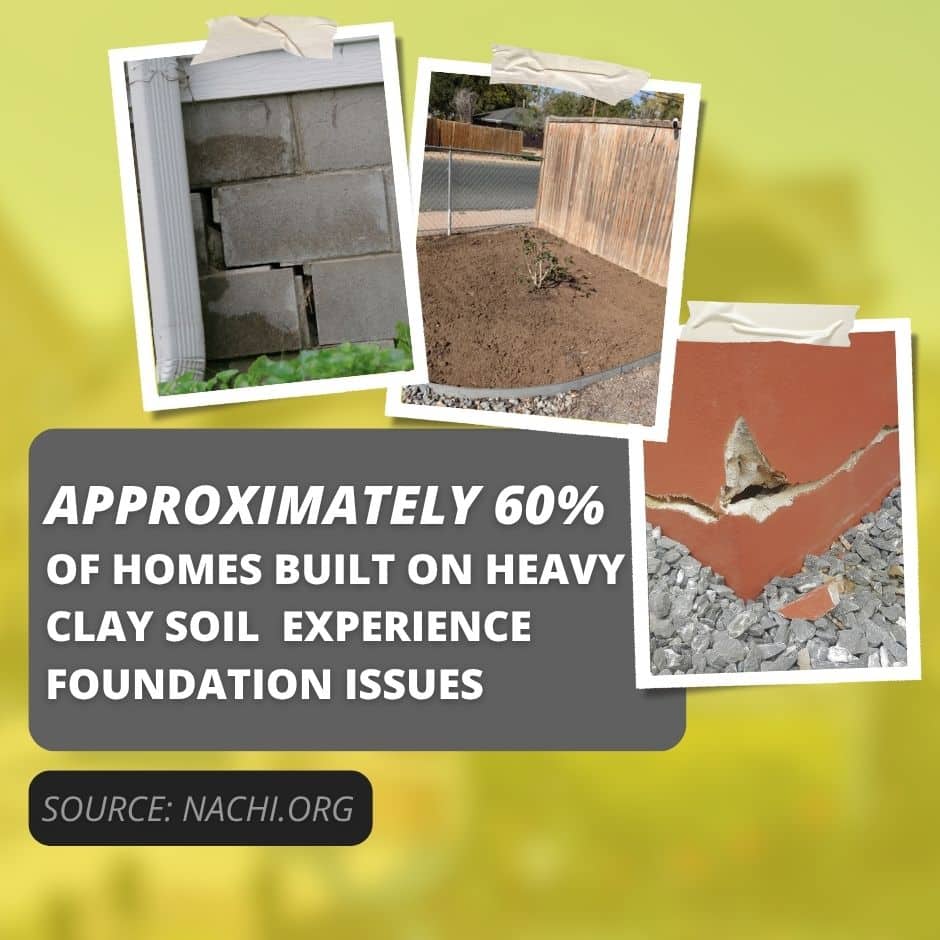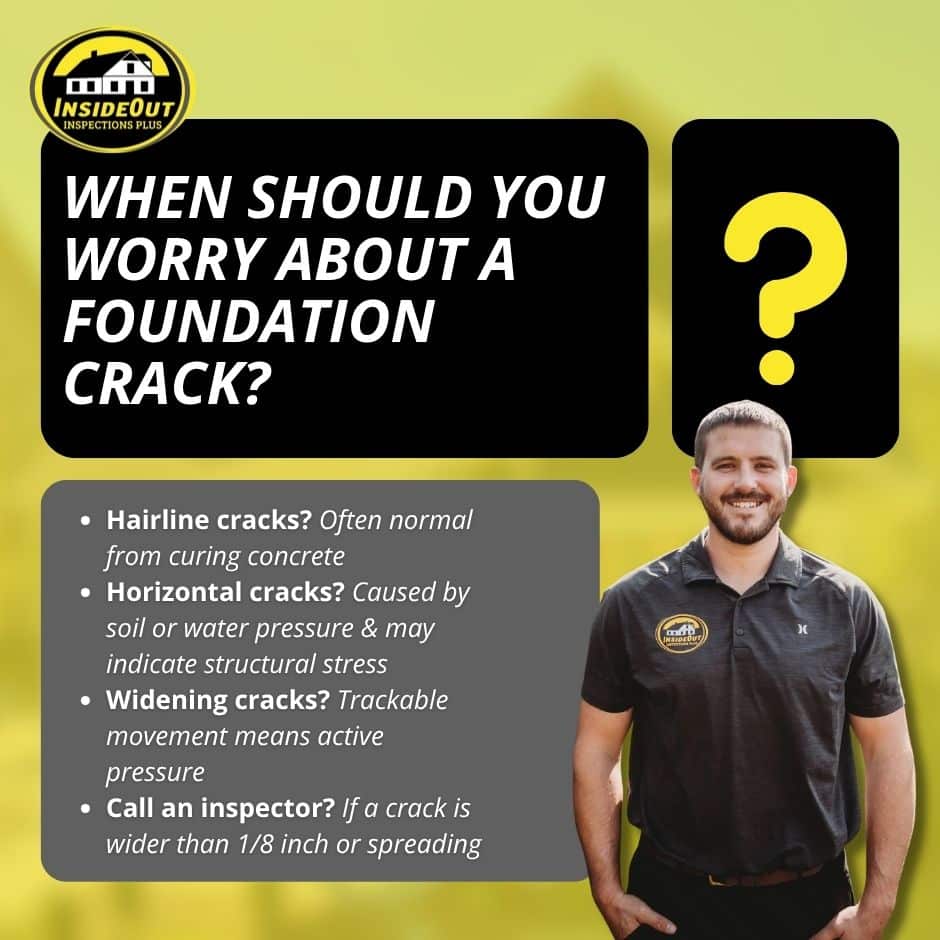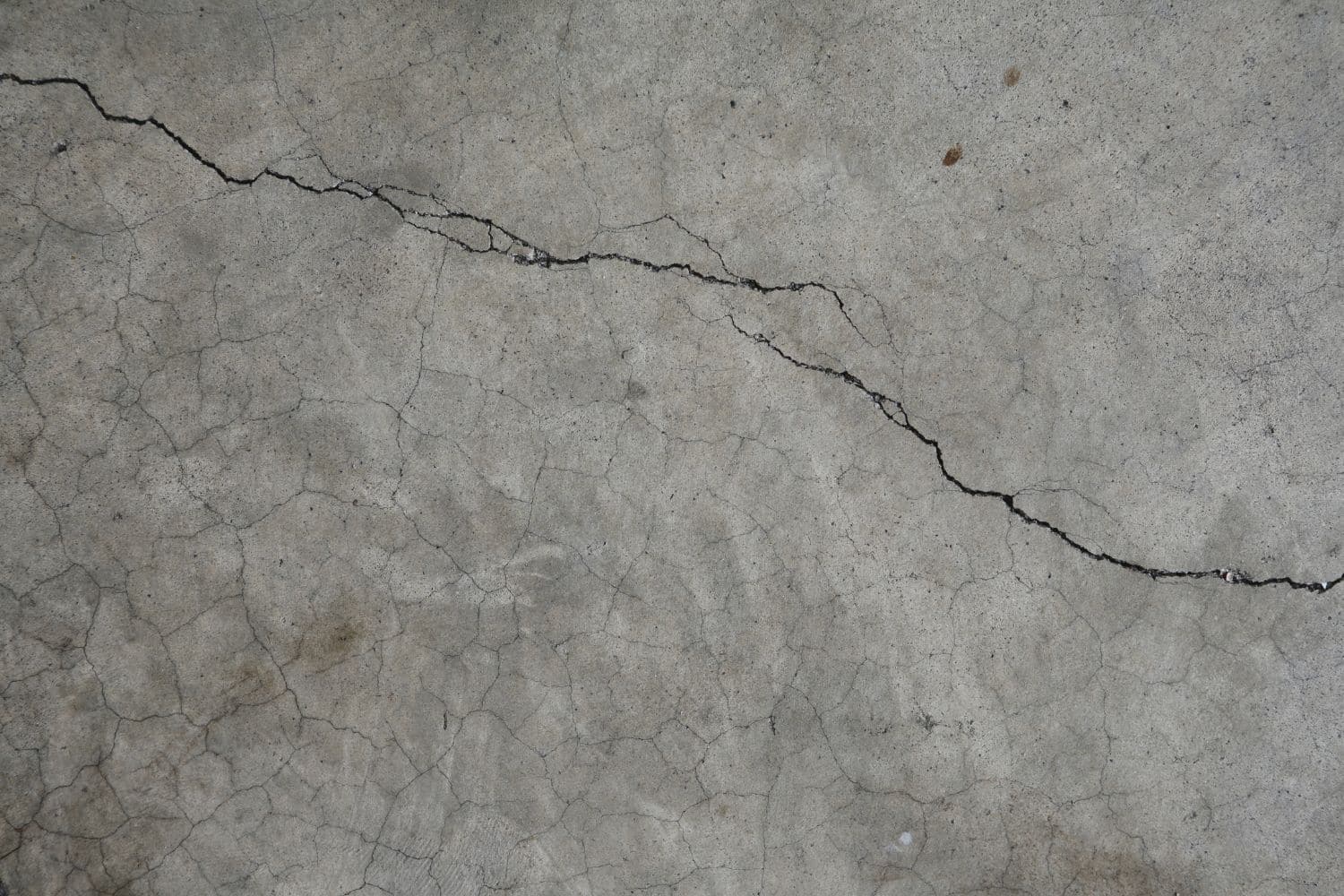Horizontal foundation cracks can be a red flag for homeowners, especially in regions with heavy soil and frequent freeze-thaw cycles like Michigan and Ohio. While not every crack signals structural failure, these lines can reveal how soil pressure, water intrusion, and time affect your home’s foundation.
At InsideOut Inspections Plus, our inspectors see horizontal cracks in all types of homes, from new builds to older properties.
This guide explains what these cracks mean, what causes them, and how an inspection helps determine whether they are stable or developing into a more serious concern.
Why Horizontal Cracks Deserve Attention
The direction of a crack often tells inspectors more than its size. Horizontal cracks are caused by sideways pressure on foundation walls rather than the natural settling that leads to vertical cracks.
| Crack Direction | Common Cause | Severity | What It Suggests |
| Vertical | Settling or drying concrete | Usually low | Cosmetic or minor |
| Diagonal | Uneven soil settling | Moderate | Soil or water imbalance |
| Horizontal | Pressure from soil or water | High | Structural stress or wall movement |
Saturated clay soil can exert over 5,000 pounds of lateral force per cubic yard when fully expanded. In fact, in homes built on heavy clay soil, approximately 60% will experience foundation issues.
That pressure pushes directly on foundation walls, and over time, it can cause cracking or bowing.
Our inspectors focus on these signs because they often indicate ongoing stress that could worsen with seasonal changes or water intrusion.
Most Common Causes of Horizontal Foundation Cracks
Every property is different, but these are the leading factors we identify across Michigan and Ohio homes.
1. Hydrostatic Pressure from Water
When soil becomes waterlogged, it grows heavier and pushes against foundation walls. This constant, uneven force is known as hydrostatic pressure.
- Homes with clogged gutters, short downspouts, or poor yard drainage often experience it.
- Cracks usually appear near the midpoint of the basement wall where pressure is strongest.
The Federal Emergency Management Agency (FEMA) notes that homes built without adequate waterproofing or grading are at higher risk for horizontal cracking during prolonged rain or snowmelt.
2. Expansive or Clay-Rich Soil
Michigan and Ohio have clay-heavy soils that swell when wet and shrink when dry. This expansion and contraction create repeated stress cycles that weaken concrete block walls.
- Over time, that stress causes horizontal or step-like cracks to appear.
- Our inspectors often find related signs, such as soil pulling away from the foundation during dry months, which indicates shrink-swell movement.

3. Poor Grading and Drainage
Water should move away from a home, not toward it. If the soil slopes inward or downspouts discharge near the foundation, moisture collects where it can do the most harm.
- Repeated pooling raises soil saturation and long-term wall pressure.
- Inspectors document both interior cracks and the exterior grading that might be contributing to them.
4. Seasonal Freeze-Thaw Cycles
In northern climates, the freeze-thaw cycle is a major factor. When water in the soil freezes, it expands, pressing outward on foundation walls. As it thaws, it leaves behind minor gaps that allow more water to seep in.
- The National Association of Home Inspectors (InterNACHI) reports that repeated frost expansion can double a wall’s lateral load during winter months.
- Our inspectors look for bowing or small shifts that align with seasonal soil patterns.
5. Original Construction or Backfill Issues
Occasionally, horizontal cracks stem from early construction stress. If a builder backfilled too soon after pouring the foundation or used poorly compacted soil, that uneven pressure can lead to cracking years later.
- Inspectors can often distinguish this type of crack by its height and shape.
- While not always active, it still warrants monitoring over time.
Early Warning Signs of Foundation Movement
Horizontal cracks rarely occur alone. They often appear with other small but important symptoms that indicate soil pressure or wall movement.
Common clues:
- A faint inward curve in basement or crawl-space walls
- Stair-step cracks following mortar joints in block walls
- Musty odors or damp spots where moisture seeps in
- Gaps between floors and baseboards
- Sticking doors or windows near the lower level
- Paint bubbling or flaking from trapped humidity
Homeowners often first notice musty smells or sticky windows rather than visible cracks. These smaller changes can signal pressure building behind the walls before damage becomes visible.
How Inspectors Evaluate Horizontal Cracks
At InsideOut Inspections Plus, our approach is non-invasive, thorough, and evidence-based. We inspect both the foundation and the surrounding conditions to understand the complete picture.
A typical foundation inspection includes:
- Exterior Review: Checking soil slope, gutter discharge, and water paths to identify drainage problems.
- Interior Documentation: Measuring crack length, width, and pattern to determine whether it’s horizontal, diagonal, or step-formed.
- Moisture Readings: Using moisture meters to detect hidden dampness or leaks through foundation walls.
- Wall Alignment Testing: Using levels or laser tools to check for bowing or inward lean.
- Observation of Connected Areas: Inspecting above-grade symptoms like door gaps, uneven floors, or drywall cracks that align with foundation stress.
- Photo and Report Delivery: Providing a clear, detailed report with visuals, explanations, and guidance on whether the crack appears stable or active.
The goal is clarity, not speculation. Our inspectors report what is visible and measurable, helping homeowners decide whether to monitor, maintain, or seek further professional assessment.
What Horizontal Cracks Indicate for Home Safety
Horizontal cracks may look similar from the outside, but their implications vary. Our inspectors look at multiple factors before drawing conclusions.
Horizontal cracks can indicate:
- Past soil pressure that has stabilized (older, unchanged cracks).
- Ongoing lateral pressure if the crack is widening or accompanied by moisture stains.
- Potential bowing if the wall shows a measurable inward lean.
Horizontal cracks wider than one-eighth of an inch, or those that extend across multiple wall sections, often suggest continued pressure. Inspectors document these details precisely so homeowners can act early, before more costly damage occurs.

The Value of Pro Insights Over Quick Fixes
DIY sealants or patch kits may temporarily hide cracks, but they do not address the underlying pressure. In fact, they can trap moisture behind walls, making the problem worse.
A professional inspection offers measurable insight. By identifying how and why cracks formed, we help homeowners prioritize the right solutions.
For many, that means improving grading or drainage rather than expensive foundation repairs.
InsideOut Inspections Plus focuses solely on accurate observation, data-driven reporting, and homeowner education. We do not perform repairs, which means our assessments remain unbiased and objective.
Preventing Future Foundation Damage
Prevention is the best long-term approach to avoid horizontal cracks and related foundation stress. Small maintenance habits can make a big difference.
We recommend:
- Cleaning gutters twice per year and extending downspouts at least six feet from the foundation.
- Regrading soil so that it slopes away from the home by one inch per foot for at least ten feet.
- Testing sump pumps annually to ensure proper drainage.
- Avoid dense planting or heavy irrigation close to basement walls.
- Scheduling a professional inspection every few years, particularly after flooding, landscaping changes, or nearby construction.
The EPA emphasizes that consistent surface drainage maintenance reduces structural moisture problems by more than 60% over time.
When moisture control improves, the stress on basement walls often decreases naturally, preventing new cracks from forming.
Related Questions
Do Horizontal Cracks Always Mean Structural Damage?
Not always. Some are old or caused by minor soil shifts. Only a professional inspection can determine whether the pressure behind the wall is active.
Can Foundation Cracks Let Radon Into My Home?
Yes. Even small foundation cracks can allow radon gas to enter from the soil. InsideOut Inspections Plus offers radon testing to confirm whether levels are safe and recommend next steps if elevated.
Can New Homes Develop Horizontal Foundation Cracks?
Yes. Even new construction can experience horizontal cracks within the first few years as the soil settles or drainage shifts.
When to Book a Professional Inspection
If you notice a horizontal crack or suspect wall movement, it’s time to schedule a professional inspection. Early documentation helps you catch small issues before they grow.
InsideOut Inspections Plus provides complete home and foundation inspections across Michigan and Ohio. We identify what’s happening, explain why it’s occurring, and recommend whether to monitor or seek specialized evaluation.
Our reports give homeowners the confidence to make informed decisions about their property, without guesswork.
Conclusion
Horizontal cracks often signal that your foundation is under stress, but not all cracks are cause for alarm. Understanding their cause, location, and activity level begins with a professional inspection.
InsideOut Inspections Plus helps homeowners in Michigan and Ohio uncover the story behind every crack through clear, data-based reporting. With expert insight and local experience, we make it easier to protect your home from the ground up.
If you’ve seen a horizontal crack or other signs of foundation stress, schedule your inspection today and gain peace of mind through a clear, professional evaluation.


